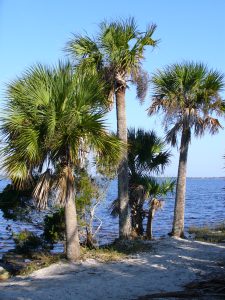Cabbage Palm, Sabal palmetto

Photo by Scott Zona

Photo by Scott Zona
Height: 20-60 feet
Spread: 8-10 feet (palm frond canopy)
LANDSCAPE USE
Often planted in small groups to accent homes or buildings. Regularly and often planted in city, county, and state parks and recreation areas as well as along the shoulders and in the medians of state and interstate highways. The cabbage palm’s overall hardiness and durability also make it an excellent choice for difficult situations, including retention ponds, drainage swales, canal banks, and commercial parking lots.
FORM
An erect fan palm with a grayish trunk that is sometimes smooth and other times covered with “boots” (the remaining bases of fallen leaves).
NATIVE RANGE
Pinelands, inland and coastal hammocks, and edges of marshes and prairies, often near limestone. South Carolina, south throughout Florida, and west to Texas. This is Florida’s state tree and our most common and widespread pal — the signature tree of the Florida skyline, and should be our first, go-to palm for any landscape.
CHARACTERISTICS
Flowers: Small, white, borne just below the leaves in conspicuous, 3-foot-long, pendent clusters. Summer.
Leaves: Semi-fan shaped, 3-5 feet wide, slightly longer, reflexed upward from the central axis, giving the leaf a V-shaped appearance. Blade divisions have threadlike fibers along their edges.
Fruit: Round, shiny black, about inch in diameter. Fall, right in time for bird migration. Sabal palmetto fruit is used by hundreds of bird species and has been found in research to be extraordinarily high in vital nutrients.
Bark: Grayish and smooth to slightly roughened on mature trees. Younger trees often retain the attractive bases of fallen leaves (boots) and these can be planted with ferns and vines.
CULTURE
Soil: Performs best in moist, fertile, somewhat sandy soil with the presence of limestone, but highly adaptable to almost any situation.
Exposure: Full sun. Intolerant of deep shade.
Water: Moist conditions are best, but very adaptable to almost any situation, except regular flooding.
Hardiness Zones: 8 to 11.
Life Span: Slow growing and at least moderately long-lived, probably reaching well over 100 years. Many historic photos suggest that these palms may live at least 200-300 years.
This palm should never be harshly pruned as has become the practice of unscrupulous maintenance companies. Removing green fronds removes nutrients from the palm and opens it up to weakening and disease.
BEST FEATURES including WILDLIFE SUPPORT
Cabbage or Sabal Palm is versatile, hardy, and easy to grow. Its fruit is eaten by wildlife and its dense crown provides excellent cover for nesting birds. Sabal Palm fruit is an exceptional, important food source for migrating birds such as Cedar Waxwings and many others. The palm’s flowers are also an exceptional nectar source for many pollinators. These features, coupled with its wide adaptability to numerous difficult situations, make it an exceptional Florida native landscape plant. At its best when planted in clusters.
COMPANION PLANTS
Live Oak (Quercus virginiana), Beautyberry (Callicarpa amcricana), Red Bay (Persea borbonia), Sugarberry (Celtis laevigata), Flatwoods Plum (Prunus umbellata), Red Maple (Acer rubrum), Oaks (Quercus spp.), Sweetbay and Magnolia (Magnolia virginiana and M. grandiflora),Loblolly Bay (Gordonia lasianthus), Coontie (Zamia pumila).
DISADVANTAGES
A number of epiphytic plants get their start on this tree in southern Florida. This may or may not be a problem. The most troublesome often is Strangler Fig (Ficus aurea), which can eventually destroy a Sabal Palm if not removed. However, some property owners choose to selectively allow Strangler Figs to develop over time. But in most commercial settings, this cannot be allowed.
Avoid planting this palm where fronds or dropping fruit will be a conflict. Fronds are not a damage or safety hazard and can be allowed to drop and be picked up. Fruit can be “blown” or vaccumed away or left for wildlife to feast upon. Palm seedlings are easily plucked from the ground when young, but are more difficult if left to grow to a foot or more, so attend to them quickly.
SIMILAR AND RELATED SPECIES
Several other tree-sized palms are native to Florida. The Brittle and Florida Thatch Palms (Thrinax morrisii and T. radiata), Paurotis Palm (Acoelorrhaphe wrightii), Sargent’s Cherry Palm (Pseudophoenix sargentii), and Royal Palm (Roystouea regia) are all available in the native plant trade and are excellent substitutes for any of the multitude of non-native palms that are sometimes planted in the state, and can be the source of diseases harmful to both non-native and native palms.
A wonderful read on our state tree is the The Palmetto Book, Histories and Mysteries of the Cabbage Palm, by Jono Miller, a dedicated fan of Sabal palmetto and very entertaining and informative speaker. FANN highly recommends him and his writings!